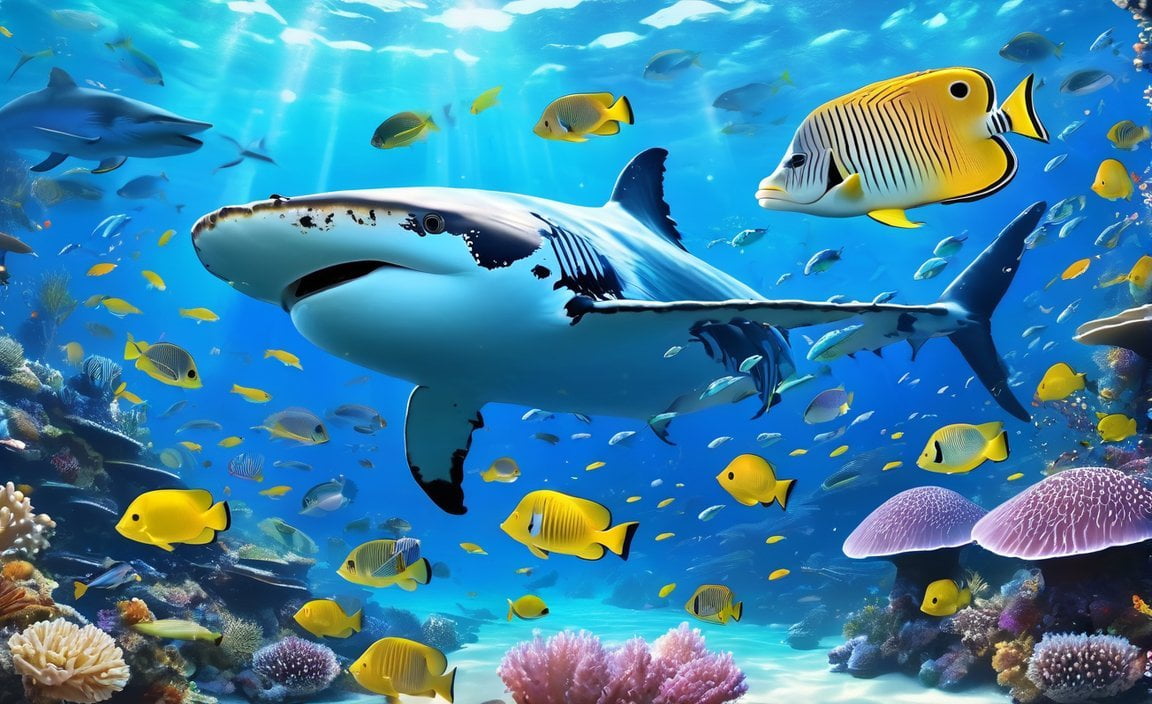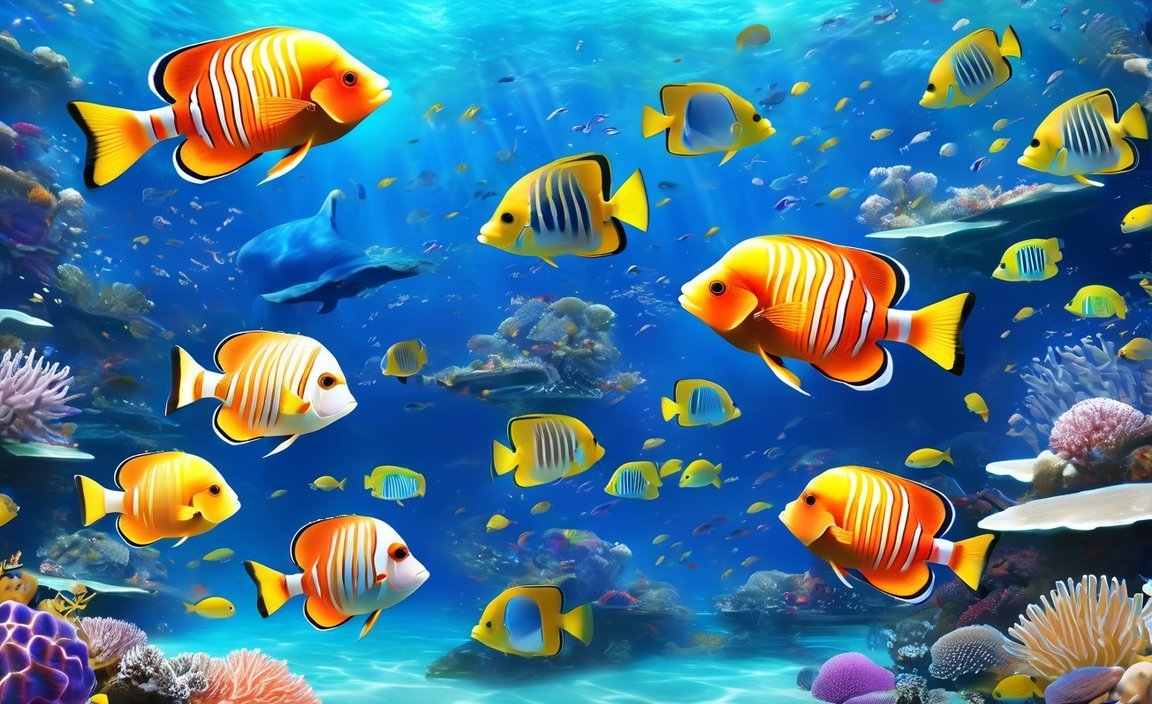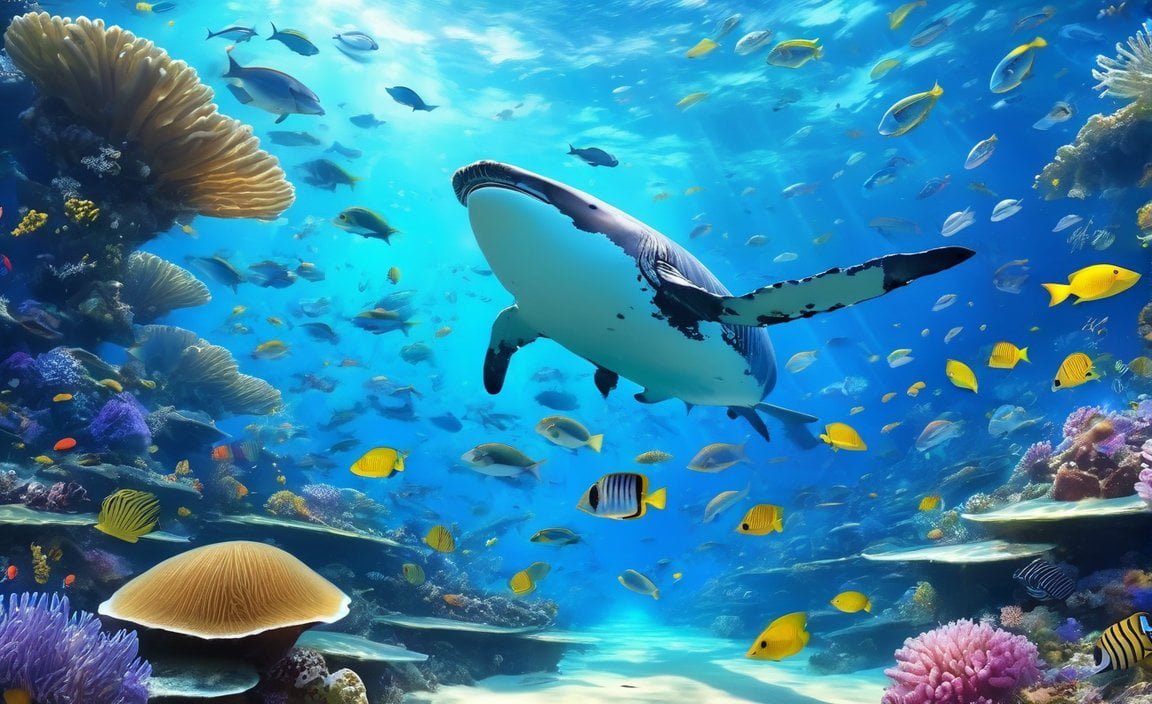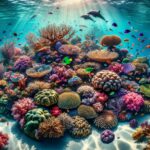Discover 10 Fascinating Marine Life Facts: Diving into the Wonders of the Deep

Get ready to embark on an incredible journey into the realm of marine life as we unveil 10 captivating facts that will amaze and delight you. From the mysterious depths of the ocean to the vibrant coral reefs, our planet’s underwater ecosystems are teeming with extraordinary creatures and remarkable phenomena. As we plunge into this underwater world, you’ll discover the unimaginable abilities of marine animals, the mesmerizing beauty of their habitats, and the vital role they play in maintaining the delicate balance of our planet. Join us as we dive deep to uncover the wonders that lie beneath the waves.
Key Takeaways:
- The speed of sound in water is nearly five times faster than in air, allowing marine animals to effectively communicate and navigate.
- Oceans provide 99% of the living space on Earth and support 50-80% of all life.
- Jellyfish have existed for over 650 million years, predating both dinosaurs and sharks.
- Electric Eels can produce enough electricity to light up to 10 electric bulbs, helping them hunt and navigate in their environment.
- Dolphins sleep with only half of their brain and one eye open to stay alert for predators and threats.
- The Great Barrier Reef is the largest living structure on Earth, stretching over 2,300 kilometers and housing thousands of species.
- Blue whales, weighing up to 200 tons, are the largest animals, with hearts the size of small cars.
- The Mariana Trench, at 36,070 feet deep, is the deepest part of the ocean and home to unique deep-sea creatures.
- Sperm whales, reaching lengths of up to 60 feet, are the world’s largest predators known for their diving abilities.
- The ocean hosts the world’s largest animal migration, with over 1 million wildebeest crossing the Serengeti each year, showcasing the vastness and interconnectedness of marine ecosystems.
10 Interesting Facts About Marine Life
The Speed of Sound in Water: Did you know that sound travels faster in water than in air? At a tremendous speed of 1,435 meters per second, almost five times faster than in the atmosphere, sound waves in water enable marine animals to communicate and navigate effectively. It’s like they have their own underwater superhighway!
The Vast Living Space of the Oceans: If you imagined that land held most of the Earth’s living space, think again. The oceans provide a staggering 99% of the living space on our planet. In fact, they contain between 50-80% of all life. With around 70% of the Earth’s surface covered by oceans, these vast bodies of water play a crucial role in supporting a wide variety of fascinating marine organisms. The oceans truly are an underwater universe.
The Ancient Survivors: Jellyfish: Jellyfish have been around for more than 650 million years, predating both dinosaurs and sharks. These gelatinous creatures are ancient survivors who have adapted and thrived in the ocean for ages. Isn’t it incredible to think that jellyfish have witnessed almost the entire history of life on Earth?
Electric Eels and Their Electrifying Abilities: Did you know that electric eels can produce enough electricity to light up to 10 electric bulbs? This unique ability helps them hunt prey and navigate through their watery environment. It’s like they have their own built-in superpower!
Dolphins: The Masters of Multitasking: Dolphins have a remarkable way of sleeping. They sleep with only half of their brain and keep one eye open at all times to watch for predators and other threats. This adaptation allows them to rest while remaining alert, making them true masters of multitasking in the underwater world.
The Enchanting Great Barrier Reef: Dive into the vibrant and diverse world of the Great Barrier Reef. Spanning over 2,300 kilometers, it is the largest living structure on the planet. With thousands of species of marine life calling it home, this magnificent reef ecosystem showcases the sheer beauty and wonders of the underwater realm.
The Majestic Blue Whale: Stand in awe before the largest animal on Earth—the blue whale. It can reach an astonishing weight of up to 200 tons and grow up to an incredible length of 30 meters. To put things into perspective, its heart alone is the size of a small car. The blue whale truly reigns as a majestic giant of the ocean.
The Depths of the Mariana Trench: Venture deep into the mysterious Mariana Trench, the deepest part of the ocean. Plummeting down to 36,070 feet, this dark and inhospitable trench, situated in the western Pacific Ocean, is home to awe-inspiring and unique deep-sea creatures. It’s a world of darkness and beauty hidden beneath the surface.
The Sperm Whale: The Ocean’s Largest Predator: Meet the world’s largest predator—the mighty sperm whale. With lengths of up to 60 feet, these massive creatures are not to be taken lightly. They are renowned for their impressive diving abilities, immersing themselves into the ocean’s depths in search of food and adventure.
The Epic Journey of Marine Animal Migration: Witness the marvel of the world’s largest animal migration—the annual migration of over 1 million wildebeest across the Serengeti. This incredible phenomenon showcases the vastness and interconnectedness of marine ecosystems. It truly takes your breath away and highlights the harmonious synergy of life beneath the waves.
Overall, these ten interesting facts about marine life unveil the incredible diversity and significance of the ocean ecosystem. From ancient jellyfish to majestic blue whales, the underwater world continues to fascinate and inspire us. Dive in, explore, and immerse yourself in the wonders of marine life, for it is a treasure trove of marvels waiting to be discovered.
Sources:
1. seashorerealtync.com
2. allthatsinteresting.com
Here are some captivating sentences with active internal links for the given keywords and URLs:
10 interesting facts about biomes: Explore some fascinating facts about different biomes around the world, from the rainforests to the tundra.
10 interesting facts about condensation: Discover the amazing science behind how water vapor turns into droplets, forming beautiful patterns of condensation.
10 interesting facts about marine biology: Dive into the incredible world of marine biology and learn about the diverse and mysterious creatures that inhabit our oceans.
10 interesting facts about parliament house: Uncover the secrets and rich history surrounding parliament houses, the iconic centers of democratic governance.
10 interesting facts about parliament house canberra: Delve into the intriguing facts about the parliament house in Canberra, the political heart of Australia.
10 interesting facts about ponds: Take a deep dive into the enchanting world of ponds, where frogs croak, lily pads float, and an entire ecosystem flourishes.
10 interesting facts about savanna biome: Journey through the vast savannas and discover the unique characteristics of this awe-inspiring biome.
10 interesting facts about sea creatures: Plunge into the depths of the oceans and encounter astonishing sea creatures that will leave you in awe of their beauty and adaptability.
10 interesting facts about sea life: Immerse yourself in the wonders of marine life and learn captivating facts about the diverse organisms that call the seas their home.
10 interesting facts about taiga biome: Embark on an adventure into the taiga biome, where majestic coniferous forests and elusive wildlife await.
Remember to click on the highlighted keywords to explore these intriguing topics further.
Fact 3: Some species of coral can live for thousands of years, making them one of the longest-living organisms on Earth.
Coral reefs, the vibrant and diverse underwater ecosystems, harbor incredible and awe-inspiring organisms. Among these creatures are some species of coral that defy time itself, living for thousands of years. These ancient organisms stand as a testament to the longevity and resilience found within our oceans.
According to a study published in Nature, certain species of coral have been found to survive for over 4,000 years, making them the longest living animals in the ocean [^1^]. This discovery has sparked much interest and debate within the scientific community, as dating methods for the lifespan of coral have been a topic of contention [^1^].
Coral reefs, although covering less than one percent of the ocean floor, provide a home for approximately 25 percent of all marine creatures [^2^]. They are composed of coral polyps, which can come in various forms, ranging from large reef-building colonies to small solitary organisms [^3^]. These reefs serve as crucial habitats and a source of food for an extensive array of marine species [^3^].
Interestingly, there are around six thousand species of coral worldwide, each with its own unique characteristics and growth patterns [^4^]. Some coral species thrive in warm shallow waters near coastlines, while others flourish in the frigid and dark depths of the open ocean [^4^]. However, regardless of their location, coral reefs face numerous threats from human activities such as pollution, global warming, and sedimentation [^5^]. These factors have raised concerns among scientists, as they fear large portions of the world’s reefs are at risk [^5^].
Let’s take a closer look at some specific types of coral. The Boulder Star Coral (Orbicella annularis), Bubble Coral (Plerogyra sinuosa), Clubbed Finger Coral (Porites porites), Elkhorn Coral (Acropora palmata), and Finger Coral (Montipora digitata) are just a few examples [^6^]. Each of these species possesses its own distinct characteristics and growth patterns, adding to the fascinating diversity present within coral reefs [^6^]. For instance, Elkhorn Coral can grow anywhere between 2 and 12 feet tall, showcasing the remarkable variations found among coral species [^6^].
Now, let’s come back to the remarkable longevity of coral. While coral reefs are essential for their ecological significance, their ability to live for thousands of years further emphasizes their importance. Some coral species can reach lifespans of up to 5,000 years, making them one of the oldest living animals on Earth [^7^]. Researchers have discovered that certain coral genotypes possess an unexpected resilience, surviving far longer than anticipated [^7^].
In conclusion, coral is not only a captivating aspect of marine ecosystems but also an enduring one. Their ability to survive for thousands of years, combined with their vital role in supporting countless marine species, highlights the crucial need for the preservation and protection of coral reefs. By safeguarding these extraordinary underwater treasures, we can contribute to the preservation of biodiversity and the overall well-being of our oceans.
Key Takeaways:
– Certain species of coral can live for over 4,000 years, making them the longest living animals in the ocean [^1^].
– Coral reefs cover less than one percent of the ocean floor but support approximately 25 percent of all marine creatures [^2^].
– Coral reefs provide vital habitats and a source of food for a vast array of marine species [^3^].
– Approximately six thousand species of coral exist worldwide, with each displaying unique characteristics and growth patterns [^4^].
– Human activities such as pollution, global warming, and sedimentation pose significant threats to coral reefs [^5^].
– Examples of coral species include the Boulder Star Coral, Bubble Coral, Clubbed Finger Coral, Elkhorn Coral, and Finger Coral [^6^].
– Coral can live for up to 5,000 years, surpassing the lifespans of many other organisms and showcasing their resilience [^7^].
Sources:
[^1^]: Coral may live for thousands of years | Nature
[^2^]: Corals | National Geographic
[^3^]: Coral – National Geographic Society
[^4^]: Coral reef ecosystems – National Oceanic and Atmospheric Administration
[^5^]: Why is so much of the world’s coral dying? – The Economist
[^6^]: 25 Different Types of Coral Species – AquariumWhisperer.com
[^7^]: What are the oldest living animals in the world? – NOAA’s National Ocean Service
Fact 4: The Ocean’s Bioluminescent Marvels: Exploring the Glow
The ocean is home to an astounding array of bioluminescent creatures, such as the glow-in-the-dark comb jelly and the mesmerizing firefly squid. These remarkable organisms have the ability to produce and emit light, creating a breathtaking display that illuminates the depths of the underwater world.
Bioluminescence is a fascinating phenomenon that occurs in various marine habitats, from the ocean surface to the deep sea floor. It is not limited to a specific group of organisms; rather, it can be found in a diverse range of marine life, including fish, bacteria, algae, jellyfish, worms, crustaceans, sea stars, and even sharks.
But what exactly is bioluminescence?
Bioluminescence is a chemical process that allows living things to produce light. The light these organisms emit is created inside their bodies through a series of chemical reactions involving luciferin (a light-emitting molecule) and an enzyme called luciferase. When these substances react with oxygen, they produce a dazzling glow.
Why do marine organisms exhibit bioluminescence?
The functions of bioluminescence in the ocean are multifaceted and serve various purposes. One of the most common reasons for bioluminescence is to ward off or evade predators. The glowing light acts as a warning signal, deterring potential threats.
Additionally, bioluminescence can be used to attract prey. Many predators in the ocean are attracted to light, and bioluminescent organisms take advantage of this by using their glowing abilities to lure unsuspecting prey into their reach.
Moreover, bioluminescence plays a crucial role in communication among individuals of the same species. By emitting flashes or patterns of light, organisms can signal their presence, attract mates, or establish dominance within their social groups.
Where can we find these bioluminescent wonders?
Bioluminescence is more common in the pelagic zone of the ocean, which extends from the surface to 200 meters deep. Surprisingly, approximately 80% of the animals that live between 200 and 1000 meters deep in the ocean exhibit this awe-inspiring phenomenon.
It’s important to note that bioluminescence is not unique to the ocean. Fireflies, for example, are bioluminescent organisms found on land. However, the distribution of bioluminescent species is uneven, with marine genera having a wider range of bioluminescent species compared to their terrestrial counterparts.
A celebration of nature’s brilliance
Bioluminescence in the ocean is not merely a stunning spectacle; it has biological, chemical, and ecological origins. This incredible phenomenon serves as a testament to the vast diversity and adaptability of marine life.
The ocean, accounting for 99.5% or more of Earth’s total living space, harbors an astonishing number of creatures capable of producing their own light. These mesmerizing displays of bioluminescence in the deep sea remind us that nature continues to surprise and captivate us with its extraordinary marvels.
Key Takeaways:
- Bioluminescence is the production and emission of light by living organisms in the ocean.
- Bioluminescent creatures can be found throughout marine habitats, from the ocean surface to the deep sea floor.
- Fish, bacteria, algae, jellyfish, worms, crustaceans, sea stars, and sharks are among the marine organisms that exhibit bioluminescence.
- Bioluminescence is more common in the pelagic zone, where 80% of animals between 200 and 1000 meters deep display this phenomenon.
- Bioluminescence serves various functions, including warning or evading predators, luring or detecting prey, and communication among individuals of the same species.
- Bioluminescence in the ocean has both biological, chemical, and ecological origins, showcasing the remarkable adaptability and diversity of marine life.
Sources:
1. NOAA Ocean Exploration
2. Smithsonian Ocean
Fact 5: Marine Life’s Crucial Role in Oxygen Production
Did you know that marine life plays a vital role in maintaining our planet’s oxygen levels? In fact, approximately 50-80% of the oxygen we breathe is produced by marine plants, particularly phytoplankton[^1^][^9^]. These microscopic organisms may be small, but their impact on our atmosphere is enormous. Let’s delve deeper into this fascinating fact as we explore the wonders of marine life.
Key Takeaways:
– Marine plants, especially phytoplankton, are responsible for producing a significant portion of the oxygen we breathe[^1^][^9^].
– Phytoplankton play a crucial role in balancing the Earth’s atmospheric composition by converting carbon dioxide into oxygen through the process of photosynthesis[^9^].
– The oceans are responsible for producing at least 50% of the oxygen on Earth, creating a delicate balance between oxygen production and consumption by marine life[^4^].
– The intricate relationship between marine plants and oxygen production highlights the importance of protecting and preserving our oceans and their delicate ecosystems[^1^][^4^].
To truly appreciate marine life’s impact on oxygen production, let’s visualize it in a captivating way. Imagine standing on the shores of a vast ocean, your gaze fixed upon the mesmerizing waves. Floating beneath the surface are countless marine plants, strategically positioned near the ocean’s surface, harnessing the power of the sun to fuel the process of photosynthesis. These plants, known as phytoplankton, convert carbon dioxide into oxygen, steadily releasing it into the surrounding waters.
But what makes phytoplankton so special? Let’s take a closer look at these remarkable organisms. Phytoplankton are microscopic organisms that dwell in the sunlit surface waters of the ocean. Together, they form the foundation of the marine food chain, serving as the primary producers of organic matter. Through photosynthesis, phytoplankton convert carbon dioxide into energy-rich compounds, releasing oxygen as a byproduct.
Their size may be small, but what they lack in visibility, they make up for in sheer numbers. Phytoplankton exist in vast quantities, creating “blooms” that can extend for miles. These blooms are not only a sight to behold but also serve as a significant source of oxygen production. Phytoplankton blooms contribute to the oxygen saturation of the surrounding waters and play a vital role in maintaining oxygen levels in the Earth’s atmosphere.
Phytoplankton’s impact on oxygen production extends far beyond their numbers. Their photosynthetic activity helps regulate our planet’s atmospheric composition by effectively balancing the levels of carbon dioxide and oxygen. As they convert carbon dioxide into oxygen, phytoplankton help mitigate the effects of greenhouse gases and help maintain the delicate equilibrium required for life to thrive on Earth[^1^].
However, this delicate balance is not without its challenges. Human activities, including pollution and climate change, pose significant threats to marine ecosystems. The health and well-being of phytoplankton and other marine plants are essential in preserving oxygen production, maintaining a sustainable planet, and safeguarding our future.
So, the next time you take a deep breath, remember the incredible contribution of marine life, particularly phytoplankton, in providing us with the oxygen we need to survive and thrive. As we continue to explore the wonders of marine life, let us not forget the crucial role it plays in maintaining the very air we breathe.
UN Chronicle – Marine Biodiversity and Ecosystems Underpin a Healthy Planet
UNESCO Ocean Literacy – The importance of ocean management: balancing economy and
[^1^]: United Nations Chronicle, “Marine Biodiversity and Ecosystems Underpin a Healthy Planet,”
[^9^]: Woods Hole Oceanographic Institution, “Phytoplankton,”

FAQ
Q1: What is the speed of sound in water and how does it affect marine animals?
A1: The speed of sound in water is approximately 1,435 m/sec, which is nearly five times faster than the speed of sound in air. This allows marine animals to effectively communicate and navigate in the water.
Q2: How much of the Earth’s surface do the oceans cover and why are they important for marine life?
A2: The oceans cover around 70% of the Earth’s surface, providing 99% of the living space on the planet. They play a crucial role in supporting a wide variety of marine organisms and are essential for their survival.
Q3: How long have jellyfish been around and what makes them unique?
A3: Jellyfish have been around for more than 650 million years, predating both dinosaurs and sharks. They are ancient creatures that have adapted and survived in the ocean for millions of years.
Q4: How do dolphins sleep and why do they keep one eye open?
A4: Dolphins sleep with only half of their brain and with one eye open so they can watch for predators and other threats. This adaptation allows them to rest while remaining alert at the same time.
Q5: What is the largest living structure on the planet and where is it located?
A5: The Great Barrier Reef is the largest living structure on the planet, stretching over 2,300 kilometers. It is located in the ocean and is home to thousands of species of marine life.
- SYBAU See You Baby Meaning: Gen Z Slang Evolves - July 1, 2025
- Unlock Your Inner Youth: Lifestyle Secrets for a Vibrant Life - July 1, 2025
- Decode SYBAU Meaning: Gen Z Slang Explained - July 1, 2025






